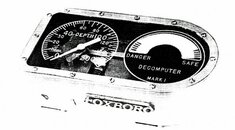- Messages
- 7,660
- Reaction score
- 4,717
- # of dives
- 200 - 499
I can't see the math:
Big clue here…
Math models can also be created to just give us the results that we know are "correct" (by statistics, "exploded goats", etc).
In school, we were all taught that the mathematics is a formal and precise way of describing something. So if you understand the math, you also get a better insight into what it is describing. Often true, certainly not always. Math is a tool that can be used in different ways.
Often,especially in modeling, you just look for a function that gives you what you want. I’ll offer an example. I wanted a function that will give me the end-of-dive group letter given the depth and time. So I searched for a function that would generate a number corresponding to a letter in the English language based on dive time and depth. Obviously this is a highly contrived situation, but no problem for "the math". "Understanding" this function is kind of pointless, it is just a function that gives me what I want, nothing more. Just for grins, here it is from one of my past posts:
Found a well-behaved function(well behaved for the intent of extrapolation) that predicts “NOAA No-Deco Air”end of dive Group Letter. (NOAA Diving Manual pg III-1) Quickest way to checkits utility is via Excel, shared below:
=(EXP((3.0343259 + (-15.355991/LN(DepthInFt))))*TimeInMinutes^0.72366692) InExcel, make a depth and time cell first, highlight “DepthInFt” and replace withthe depth cell, similar treatment for “TimeInMinutes“…
Nothing to understand other than an exponential function best fits the requirement. OK, OK, a bit of insight there...
I too see dive computers and tables as VERY, VERY similar things. The DC is just able to chop your dive into smaller increments and give you a dive-time advantage of not having to be overly cautions. However, there are times when tables will better serve you and not just because they are more conservative than a dive computer. Picking the algorithm that best describes YOU is advantageous. This is not an elementary task.
Mark Powell’s book really is that good, I’ve re-read it several times.
…//…I don't think we know ANYTHING about whether the models are simulations of what's going on in the human body. …//…
Big clue here…
…//…What we know is that the models create limits that result in an acceptably low incidence of symptomatic DCS.
Math models can also be created to just give us the results that we know are "correct" (by statistics, "exploded goats", etc).
…//… I can't see the math …//….
In school, we were all taught that the mathematics is a formal and precise way of describing something. So if you understand the math, you also get a better insight into what it is describing. Often true, certainly not always. Math is a tool that can be used in different ways.
Often,especially in modeling, you just look for a function that gives you what you want. I’ll offer an example. I wanted a function that will give me the end-of-dive group letter given the depth and time. So I searched for a function that would generate a number corresponding to a letter in the English language based on dive time and depth. Obviously this is a highly contrived situation, but no problem for "the math". "Understanding" this function is kind of pointless, it is just a function that gives me what I want, nothing more. Just for grins, here it is from one of my past posts:
Found a well-behaved function(well behaved for the intent of extrapolation) that predicts “NOAA No-Deco Air”end of dive Group Letter. (NOAA Diving Manual pg III-1) Quickest way to checkits utility is via Excel, shared below:
=(EXP((3.0343259 + (-15.355991/LN(DepthInFt))))*TimeInMinutes^0.72366692) InExcel, make a depth and time cell first, highlight “DepthInFt” and replace withthe depth cell, similar treatment for “TimeInMinutes“…
Nothing to understand other than an exponential function best fits the requirement. OK, OK, a bit of insight there...
Computers and tables find their base in an often identical "complex mathematical algorithm." The difference is only in the display, think of a computer as an animated cartoon of the "complex mathematical algorithm" and tables as a series of snapshots of the"complex mathematical algorithm." The math is exactly the same, or at least very close.
I too see dive computers and tables as VERY, VERY similar things. The DC is just able to chop your dive into smaller increments and give you a dive-time advantage of not having to be overly cautions. However, there are times when tables will better serve you and not just because they are more conservative than a dive computer. Picking the algorithm that best describes YOU is advantageous. This is not an elementary task.
Mark Powell’s book really is that good, I’ve re-read it several times.






